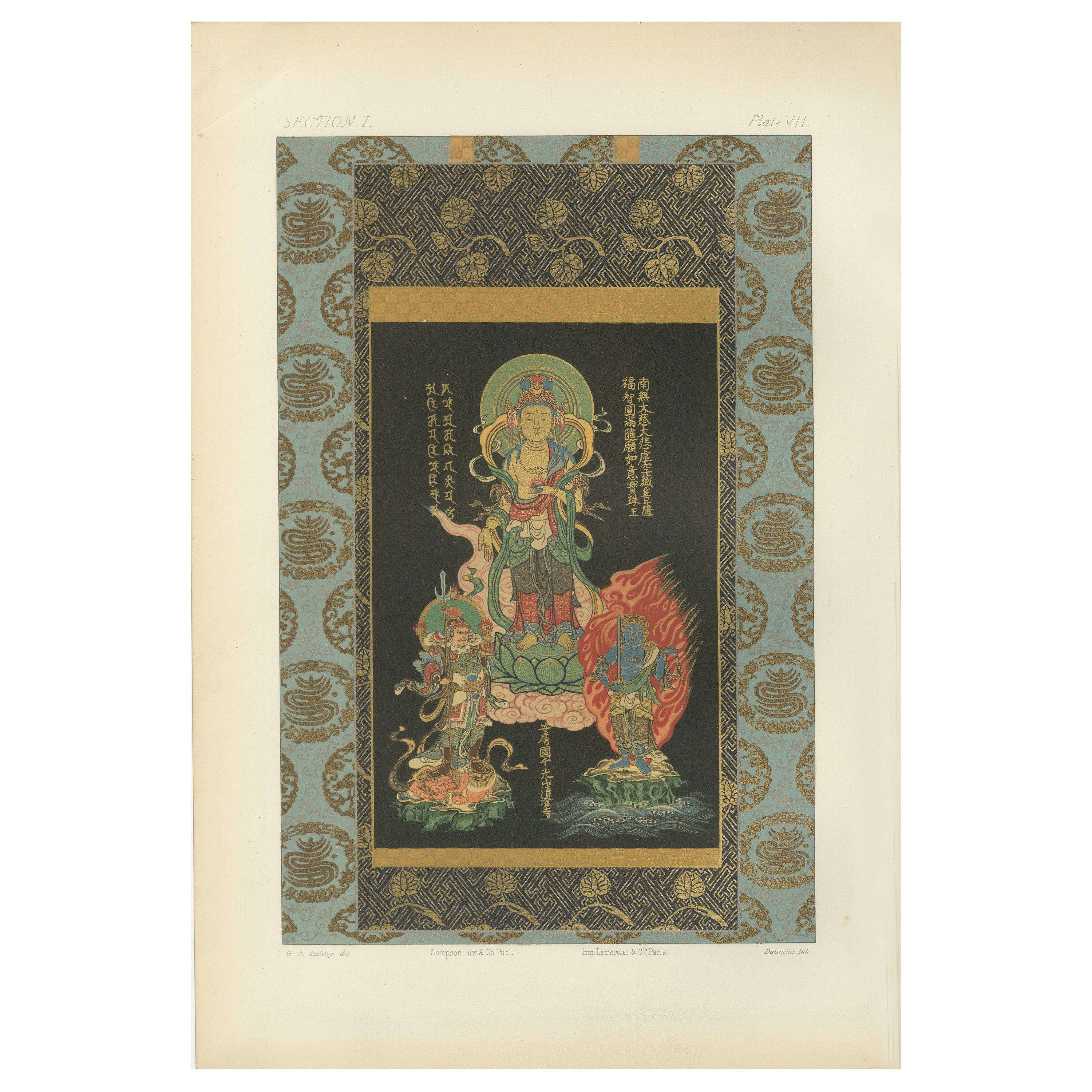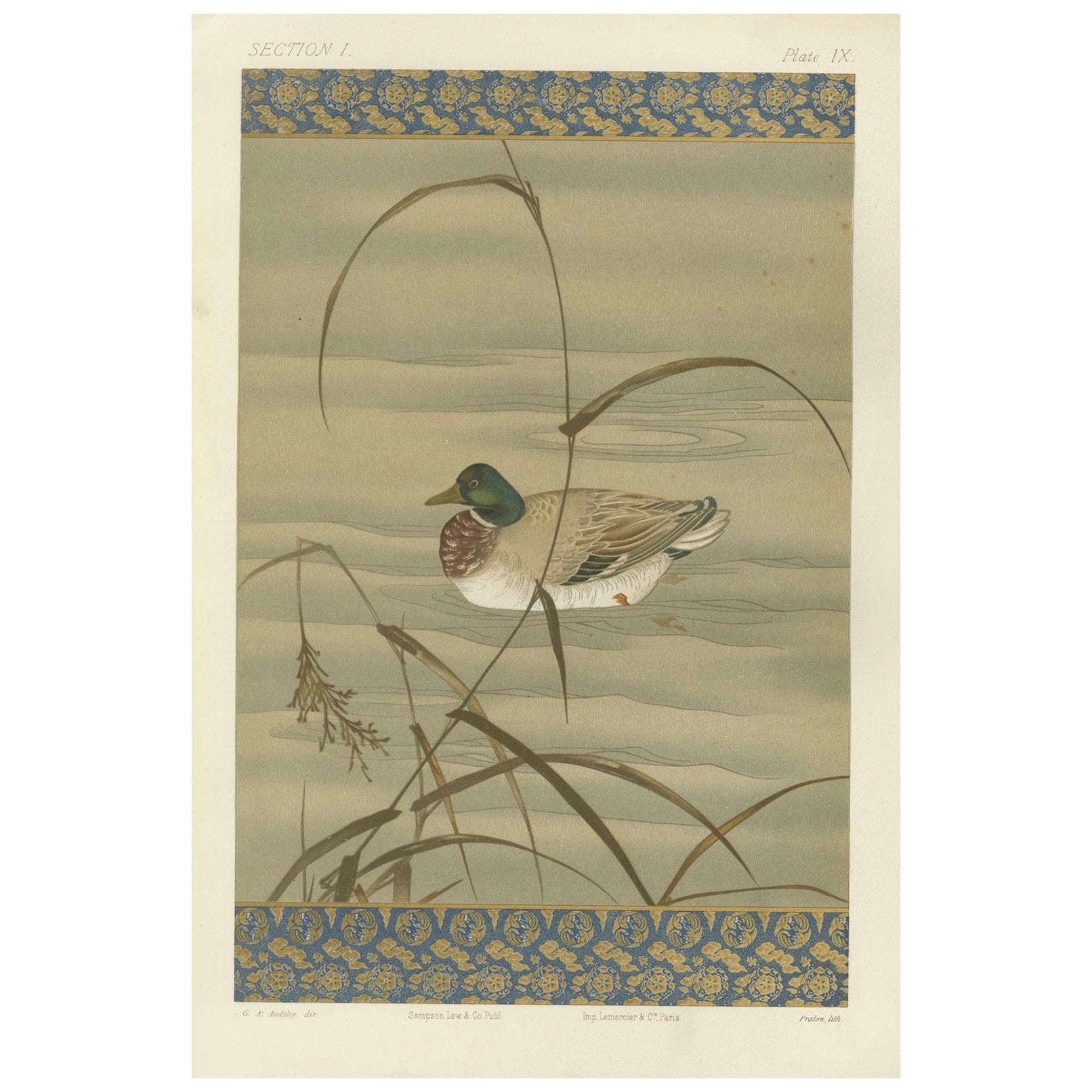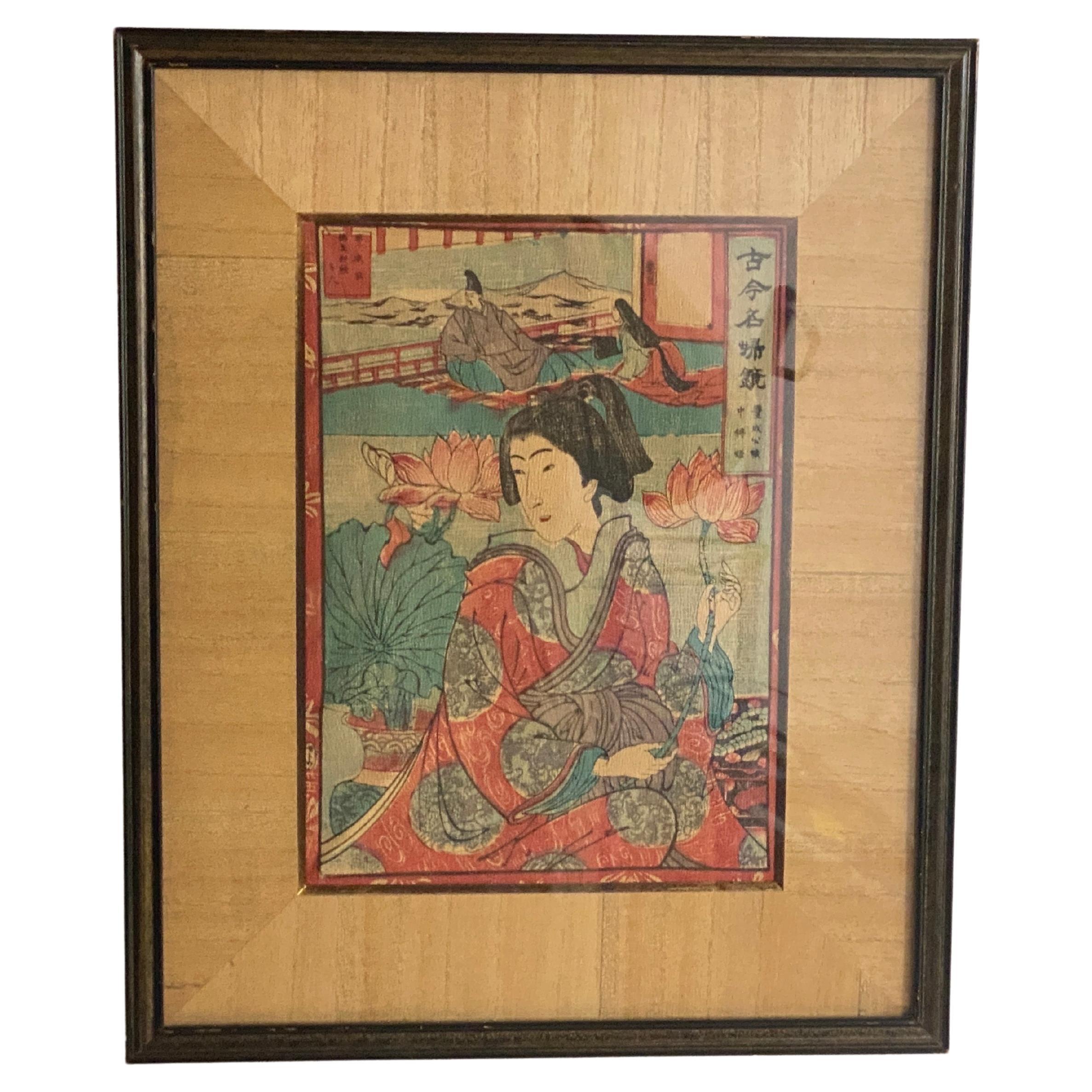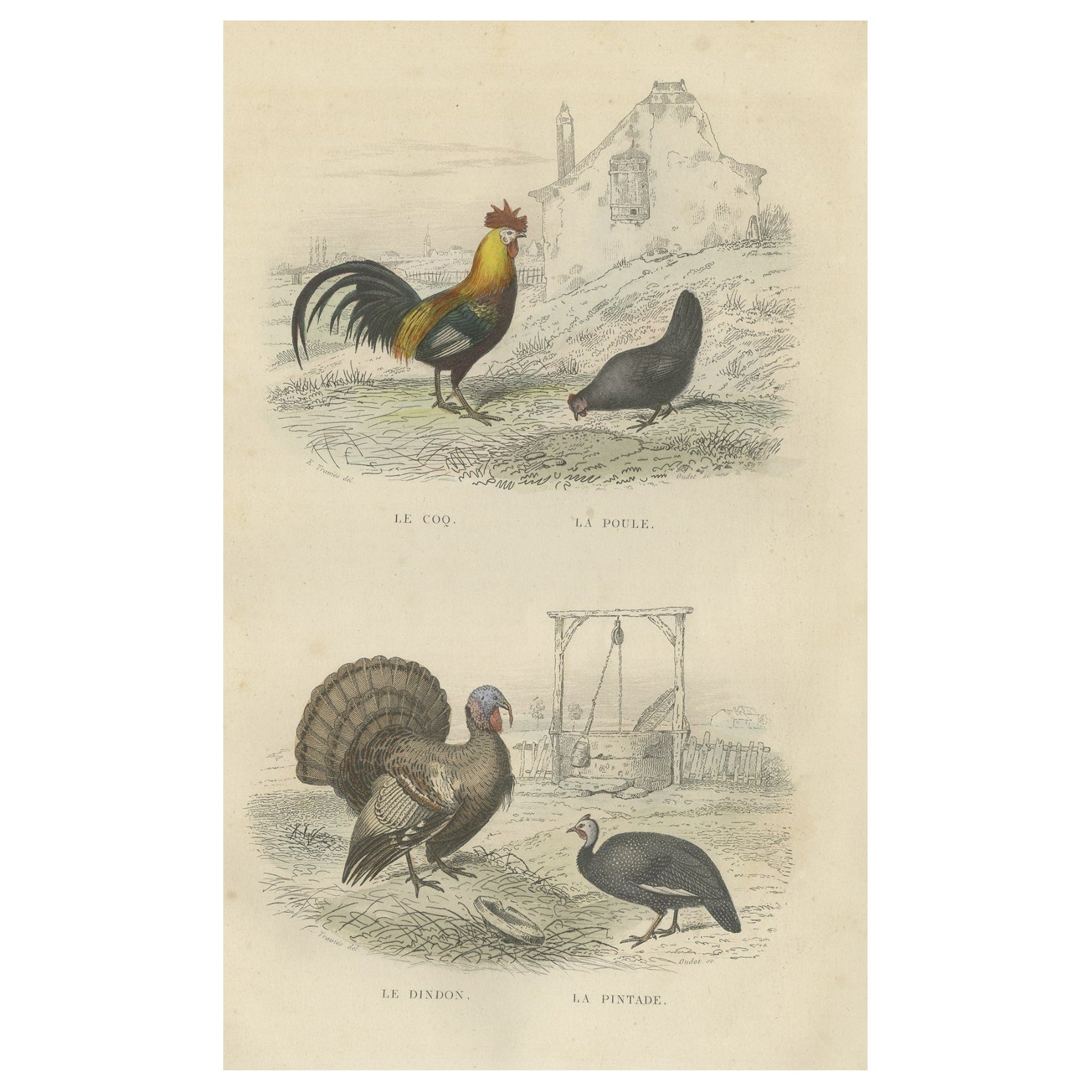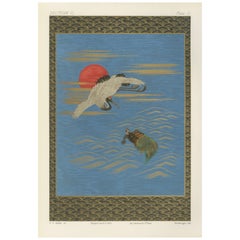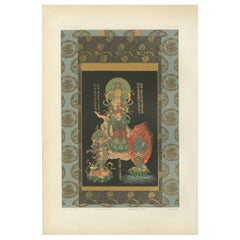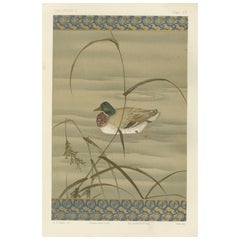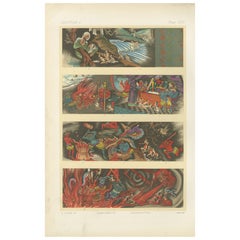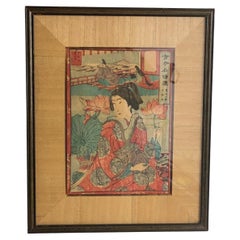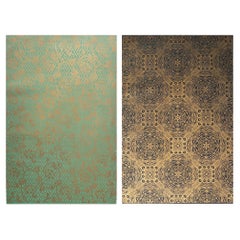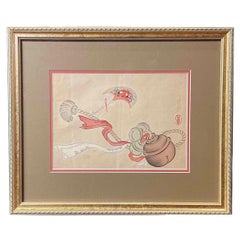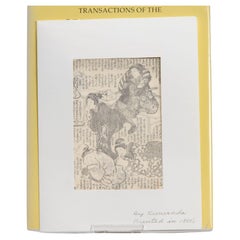Articles similaires à Antique Japanese Rooster and Hen Print: Symbolic Beauty, 19th Century
Vous voulez plus d'images ou de vidéos ?
Demander au vendeur plus d'images ou de vidéos
1 sur 10
Antique Japanese Rooster and Hen Print: Symbolic Beauty, 19th Century
À propos de cet article
Antique Japanese Rooster and Hen Print: Symbolic Beauty, 19th Century
This vibrant 19th-century Japanese print beautifully captures a proud rooster and an attentive hen, standing on an ornate, dragon-adorned pedestal with stylized waves swirling around them. Published by Sampson Low & Co. and lithographed in Paris by Imp. Lemercier & Cie, this piece is part of a larger series produced under the direction of G. A. Audsley—an important figure in promoting Japanese art to Western collectors.
The bold colors and exquisite detailing bring the birds to life, their rich plumage rendered in striking golds, reds, and deep greens. The rooster’s strong stance and majestic tail feathers contrast with the gentle form of the hen, creating a harmonious balance of strength and quiet grace. Beneath them, the dragon emblem further enriches the composition, symbolizing power, protection, and cosmic energy in Japanese mythology.
Roosters and hens hold special significance in Japanese culture. The rooster, often associated with dawn and renewal, is a symbol of vigilance and auspicious beginnings. The hen, with her nurturing presence, symbolizes domestic harmony and maternal care. Together, they embody themes of balance, prosperity, and the cycles of life—values deeply rooted in Japanese cultural philosophy.
The decorative border, with its repeating floral medallions, frames the scene with an added layer of elegance. The overall effect is one of both regal presence and cultural resonance, making this print a standout for collectors of Japanese art or those seeking to infuse their space with a sense of timeless symbolism.
Here’s a more in-depth look at the cultural significance of the rooster and dragon motifs, along with additional historical context to enrich the listing:
In Japanese folklore and symbolism, the rooster is a creature of both the earthly and the spiritual worlds. Its crowing at dawn signifies the banishing of darkness and the arrival of new light, making it a symbol of renewal, vigilance, and protection. Roosters are also associated with the Shinto deity Amaterasu, the sun goddess, as they are said to have called her back from hiding and restored sunlight to the world—a powerful emblem of hope and rebirth.
The hen, by contrast, represents the quieter virtues of domesticity, stability, and nurturing. In art, the pairing of the rooster and hen can signify the harmonious balance of masculine and feminine forces—strength paired with care, dynamism with quiet support.
The dragon is another profound motif in Japanese art, embodying elemental power, wisdom, and protection. While dragons are common in Chinese art as well, Japanese dragons are typically seen as benevolent water deities, guardians of rivers and seas. In this print, the dragon’s presence beneath the birds hints at a world of mythic protection and the cosmic cycles that govern the natural world. Together with the rooster and hen, the dragon completes a triad of symbols for power, balance, and renewal.
This print is a wonderful example of Meiji-era fascination with blending mythic symbolism and naturalist depiction—elegant in execution yet deeply layered in meaning. It offers a moment of contemplation on the interconnectedness of daily life, mythology, and the eternal rhythms of nature.
Condition Report:
The print is in excellent condition, with vibrant colors and only minor foxing or age-related marks at the margins. The central image remains crisp and deeply engaging.
Framing Tips:
Opt for a classic black or deep wooden frame to anchor the rich colors of this piece. A white or cream mat will create a harmonious transition, highlighting the intricate detail and the dynamic composition of the print.
- Dimensions:Hauteur : 40 cm (15,75 po)Largeur : 27,5 cm (10,83 po)Profondeur : 0,2 mm (0,01 po)
- Matériaux et techniques:
- Période:
- Date de fabrication:circa 1882
- État:The print is in excellent condition, with vibrant colors and only minor foxing or age-related marks at the margins. The central image remains crisp and deeply engaging.
- Adresse du vendeur:Langweer, NL
- Numéro de référence:Vendeur : BG-14034-1-221stDibs : LU3054345213502
À propos du vendeur
5,0
Vendeur reconnu
Ces vendeurs prestigieux sont des leaders du secteur. Ils représentent le summum en matière de qualité et de design.
Vendeur Or
Vendeurs premium dont la note est supérieure à 4,3 et le délai de réponse de 24 heures maximum
Établi en 2009
Vendeur 1stDibs depuis 2017
2 446 ventes sur 1stDibs
Temps de réponse habituel : 1 heure
- ExpéditionRecherche du devis...Expédition depuis : Langweer, Pays-Bas
- Politique des retours
Certaines parties de cette page ont été traduites automatiquement. 1stDibs ne garantit pas l'exactitude des traductions. L'anglais est la langue par défaut de ce site web.
Garantie d'authenticité
Bien qu'il soit peu probable que la situation se présente, dans le cas où vous rencontreriez un problème d'authenticité d'un article, contactez-nous dans un délai d'un an pour obtenir un remboursement intégral. DétailsGarantie de remboursement
Si votre article n'est pas conforme à la description, est endommagé pendant le transport ou ne vous est pas livré, contactez-nous sous 7 jours pour obtenir un remboursement intégral. DétailsAnnulation sous 24 heures
Vous disposez d'un délai de 24 heures pour annuler votre achat sans motif.Des vendeurs professionnels agréés
Nos vendeurs de renommée mondiale doivent respecter des normes strictes en matière de service et de qualité, afin de préserver l'intégrité de nos fiches produit.Garantie d'alignement des prix
Si vous constatez qu'un autre vendeur a mis en vente le même article à un prix inférieur sur un autre site, nous nous alignerons sur ce prix.Livraison en toute confiance à l'international
Notre réseau de transporteurs de premier ordre propose des options d'expédition spécialisées dans le monde entier, y compris des livraisons personnalisées.Plus d'articles de ce vendeur
Tout afficherAntique Japanese Crane and Turtle Print: Symbolic Harmony, 19th Century
Title:
Antique Japanese Crane and Turtle Print: Symbolic Harmony, 19th Century
Description:
This exquisite 19th-century Japanese print depicts a graceful crane flying above a gently...
Catégorie
Antiquités, années 1880, Estampes
Matériaux
Papier
Antique Japanese Buddhist Deity Print with Guardians, 19th Century
Antique Japanese Buddhist Deity Print with Guardians, 19th Century
This captivating 19th-century Japanese print presents a vibrant depiction of a Buddhist deity surrounded by fierce...
Catégorie
Antiquités, années 1880, Estampes
Matériaux
Papier
Antique Japanese Waterfowl Print: Tranquil Duck in Reeds, 19th Century
Title:
Antique Japanese Waterfowl Print: Tranquil Duck in Reeds, 19th Century
Description:
This serene and beautifully detailed 19th-century Japanese print captures a tranquil momen...
Catégorie
Antiquités, années 1880, Estampes
Matériaux
Papier
Antique Japanese Buddhist Hell Scenes Print: Vivid 19th-Century Depictions
Title: Antique Japanese Buddhist Hell Scenes Print: Vivid 19th-Century Depictions
Description: This striking 19th-century Japanese print presents a vivid portrayal of Buddhist hell ...
Catégorie
Antiquités, années 1880, Estampes
Matériaux
Papier
Gravure ancienne d'un coq, d'une poule, d'une dinde et d'une pintade, 1841
Par Georges-Louis Leclerc, Comte de Buffon
Gravure ancienne intitulée "Le Coq, La Poule - Le Dindon, La Pintade". Gravure ancienne originale représentant un coq, une poule, une dinde et une pintade. Cette estampe provient du ...
Catégorie
Antiquités, XIXe siècle, Estampes
Matériaux
Papier
Antique Japanese Treasure Ship Print: Takarabune on the Waves, 19th Century
Antique Japanese Treasure Ship Print: Takarabune on the Waves, 19th Century
This magnificent 19th-century Japanese print features the iconic Takarabune, or Treasure Ship, sailing th...
Catégorie
Antiquités, années 1880, Estampes
Matériaux
Papier
Suggestions
Impression sur bois japonaise originale de l'artiste japonais 19ème siècle
Rare, original Gravure sur bois du 19e siècle. Belle estampe de l'époque Edo provenant de l'éditeur original. Encadrement de qualité avec verre de conservation dans un cadre peint e...
Catégorie
Antiquités, XIXe siècle, Japonais, Exportation chinoise, Estampes
Matériaux
Papier
Gravures anciennes originales de panneaux de soie japonaise du XIXe siècle, France, 1860
Merveilleuse paire d'estampes de panneaux de soie japonaise du 19e siècle
Superbe lustre d'or illuminé
Lithographies
Publié par A.Morel, Paris, France. circa 1860
Non enc...
Catégorie
Antiquités, années 1860, Anglais, Japonisme, Estampes
Matériaux
Papier
55 $US / ensemble
Livraison gratuite
Impression sur bois japonaise du 19ème siècle représentant un pompon de cérémonie et un éventail
Une ancienne gravure sur bois japonaise du 19e siècle représentant un gland de cérémonie. Créée au Japon au cours du XIXe siècle, cette gravure sur bois attire notre attention par sa...
Catégorie
Antiquités, XIXe siècle, Japonais, Estampes
Matériaux
Verre, Bois, Peinture, Papier
Ancienne japonaise Kunisada Japan Block Print Calligrphy Edo ou Meiji, 19e siècle
Par Utagawa Kunisada III
Un très beau bloc imprimé par Kunisada 1850'
Informations complémentaires :
Matériau : Papier
Région d'origine : Japon
Période : XIXe siècle
Japon Période de la dynastie : Période M...
Catégorie
Antiquités, XIXe siècle, Japonais, Meiji, Estampes
Matériaux
Papier
Ensemble de 9 Calligrphy Edo japonais ou chinois anciens imprimés en bloc, 19ème siècle
Certains avec quelques dommages ou pliures.
Informations complémentaires :
Matériau : Papier
Région d'origine : Japon
Période : XIXe siècle
Japon Période de la dynastie : Période Me...
Catégorie
Antiquités, XIXe siècle, Japonais, Meiji, Estampes
Matériaux
Papier
Paire de gravures sur bois japonaises anciennes du 19ème siècle attribuées à Keisai Eisen
Une belle paire d'estampes japonaises anciennes attribuées à Keisai Eisen (1790-1848), originales et présentées dans des cadres en bois de bambou doré....
Catégorie
Antiquités, XIXe siècle, Japonais, Estampes
Matériaux
Papier, Bois
1 095 $US Prix de vente / ensemble
59 % de remise

